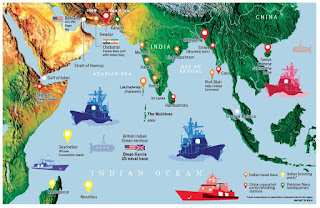Palm Oil Politics
 Photo source: The Conversation
Photo source: The ConversationBy Naveed Qazi | Editor, Globe UpFront
The
most widely used vegetable oil, in the world, over the years, has become available to consumers,
at a harrowing price.
Its production not only makes our planet warmer, but is also destroying the habitat of Sumatran Tigers, Sumatra Rhinos, and Orangutans driving these species, to near extinction.
Its production not only makes our planet warmer, but is also destroying the habitat of Sumatran Tigers, Sumatra Rhinos, and Orangutans driving these species, to near extinction.
Global
financial institutions, such as the International Monetary Fund (IMF), has
pushed Malaysia and Indonesia, on track, to produce more of this crop, leading
to severe environmental degradation, in its low-lying tropical regions, that source rainforests, and peatlands. It is because these leading global
institutions view its production, as a poverty reduction scheme. In fact, various Dutch banks itself have
provided various loans to Indonesian farmers, between 1995 to 1999.
The
business expansion has been vital to regional companies because it not only
gives a higher shelf life, to processed foods, available in the supermarket,
but is also the least expensive vegetable oil, in the world, due to its crop efficiency,
and oil versatility, in comparison, with other sources of vegetable oils. At
the same time, it also needs less available farming land than sunflower,
soybean, and rapeseed.
Palm
oil has been a staple of west Africa, and its origins are artisanal, rather
than industrial. Most palm oil, in the past, was produced by working women, by
boiling the fruit, and by pounding it to extract oil, from the pulp.
Palm
oil accounts for around thirty-five per cent of the world’s vegetable oil. In around
nine countries of the world, palm oil production has been a reason, for the country’s economic growth, and poverty reduction. But, in Indonesia, and
Malaysia, around 4.5 million people have been engaged, in this trade. Both
countries produce around eighty-five per cent of the world’s palm oil. As palm oil
trade will have a market worth of around ninety-three billion dollars, until,
2021, there are very fewer reasons for companies, to not engage in this
lucrative trade. Zion Market Research puts its growth until 2021, to 7.2 per cent.
Due to rising trade, One Map initiative keeps a sustainable record of
ownership, to prevent disputes between plantations, and indigenous communities.
Colombia,
right now, is also rigorously, pursuing palm oil production, in areas, where
illegal cocoa was grown but has a lot to match its Asian counterparts. Gabon,
one of Africa’s most forested countries, renowned for exporting okoume logs,
will also begin palm oil production, on a large scale.
According
to an article, written in the Guardian, by Paul Hills, it was a perfect
commodity for corporates, because they replaced several of their product's ingredients, with it, at a right time, and that’s why, there was no looking
back, for its producers. Now, it has penetrated so deep, in the consumer
economy, that it has become very difficult to remove it, from trading customs.
Palm
oil was a hotly debated topic, in the last Indonesian election. Generally, the populist
talk of infrastructure, giving jobs, lobbying with corporates, are convenient
reasons, for politicians, to boost their popularity. The crop has remained
active, all along, in keeping a political significance, in the country. In
1982, there were only small-scale Indonesian farmers, engaged in it, but until
2016, it has increased to a whopping forty per cent. By 2030, it might account
to around sixty per cent.
As
Joko Widodo, won a second term, there are likely chances that deforestation
would be escalated, in areas, such as Papua, Borneo, Sumatra, and beyond,
besides paradoxically propagating himself, as an environment conscious
individual, who battled destructive wildfires, and noxious haze, and propagated
several eco-smart measures. Conversely, as Indonesia is also threatening to
pull out of Paris Climate Change Protocols, there are widespread breaches of
Jokowi’s moratorium. In September 2018,
Jokowi had imposed a moratorium, on new palm oil plantations.
Jokowi,
seemingly, also wants to axe the trade with the European Union, by introducing a
measure to phase out biofuels, produced from palm oil, by 2030, mainly to
improve country’s self-sufficiency. Some say that it is a strategy, to win
buyers, in China and India, where the massive consumers belong. Indonesia is
also threatening the European Union, to bring palm oil dispute, to World Trade
Organisation’s Settlement Body (DSB).
Malaysia,
on the other hand, has been encouraging palm oil companies, to file suits,
against the European Union, and is also threatening to ban European goods,
reflecting a protectionist policy. Indonesia and Malaysia, both, also have been
promoting smaller and medium-sized producers, collectively called
‘smallholders’, in order to reduce forest loss. But in reality, they are the
biggest destroyers of forest covers, as they comprise more than fifty per cent of Indonesia’s palm oil estate. During work, human rights violations have also
occurred, such as child labour, and forced evictions, that have been generally
well documented. However, it becomes farcical to know that a Nigeria based
Institute for public policy analysis, supported by climate sceptics, wants to
help these ‘smallholders’. This scenario reflects of politics, of forest
destroying puppets, and powerful agriculture lobbies.
Malaysia,
is also looking for new markets, in Africa, for its palm oil, like its rival,
Indonesia is looking for countries, such as India and China, as its major
consumer. Africa, in fact, is the third largest consumer of palm oil, after
Southeast Asia, and South Asia, as thirteen per cent of Malaysian shipments,
were reported in Benin, Nigeria and Tanzania, as per published inputs from
Reuters. In its history, when Malaysians realised that Sabah Island, largely
devoted to cocoa, had falling world prices, most plantations switched to oil
palms. As of now, Sabah produces seven per cent of the world’s palm oil.
In
sustaining demand, the regional politicians often give a green signal, to create
forest fires, to clear forestlands. As per Nature Climate Change research paper,
published in 2014, Indonesia had the highest deforestation rate, in the world.
It has become a top reason, for high greenhouse emissions, particularly in
Indonesia. The other factor, favouring the producers, is all year round
production, due to exceptional photosynthesis qualities. It also gives the highest
yield per acre, than other crops. It is the reason, why, from 2001 to 2017,
Indonesia has lost around twenty-four million hectares, of forest cover, an
area larger than United Kingdom. Since 1973, nearly sixteen thousand square
miles of Borneo, the islands shared by Malaysia and Indonesia, have been
logged, burned, and bulldozed, to make way for palm oil production. In Indonesia, the frontier for palm oil production has been mainly the island of New Guinea,
where practices are violating Indonesian moratorium. Nearly one hundred fifty
thousand critically endangered Bornean orangutans have perished, between 1999,
to 2015, with other reasons, besides palm oil production, being logging and
hunting.
The
domination of palm oil has been the result of many factors. It has replaced
healthy fats, in the foods. Producers often keep the price of the produce low.
As it’s cheaply produced, it has become a staple food, in many Asian countries,
where Asians are now known to consume fat, in the form of palm oil.
In
history, palm oil has been given importance, due to the fact, that during
1960s, researchers began to warn, that butter’s high saturated fat content may
increase the risk of stroke. Companies, such as British-Dutch conglomerate,
Unilever, replaced butter’s high saturated fat content, with margarine, made
with vegetable oils, low in saturated fat. But, in 1990, it became clear, that
the process through which margarine was made, known as partial hydrogenation,
created a kind of fat, that was even unhealthier than trans-fat. This situation
created a dilemma, that researchers needed to figure out, how they could
replace this trans-fat, while maintaining its properties, such as remaining
solid in room temperature, a necessity for manufactured commodities, like
cookies. In the end, it became apparent that palm oil was the only choice.
Palm
oil has also replaced personal care products, animal products, and personal
care items such as soaps, shampoo, lotions, and makeup. In soaps, animal tallow
was replaced by a composition of palm oil, and palm kernel oil, as it contained
the same set of fats, like tallow.
In
current times, palm oil is bought in Europe and the US. Asia uses it far more:
India, China and Indonesia, account for nearly forty per cent, of all palm oil,
consumed worldwide. The growth has been the fastest in India, quite recently.
It is now a major part of the country’s junk food industry, and fast food market.
In the European Union, half of the palm oil goes into biofuel, and it has an advantage
over its rival, due to a low price. Currently, palm oil, used in biofuel, in
Europe should comply with standards of Renewable Energy Package (RED III),
adopted by the European Parliament. However, the value of palm oil imports, have
dropped from seventy-seven per cent to only sixteen per cent, since 1990.
According to EU’s proposed directive on renewable energy, biomass fuel
component will most probably have an exit, by 2020.
Despite
its overwhelming production, in Indonesia and Malaysia, the palm oil originally
originated from west Africa, and had been introduced from there, to Malaysia,
in 1875. A Scot named Leslie Davidson, a plantation officer, was pivotal in
discovering the crop’s pollination phenomenon, in a Unilever farm, which was
carried forward, by insects, that resembled rice weevels. When he was
transferred, to Cameroon, by his employer, he observed that pollination
occurred, more efficiently, in Cameroon. Initially, he was rebuked for his
findings, but, when he became the vice president of Unilever, he recruited
entomologists, to observe the phenomenon, After that decision, Leslie’s observations
eventually came out to be true. Leslie also concluded that Malaysia,
previously, was going with pollination all-wrong. With the result, when
pollinating weevils, were distributed all over Malaysia, the country saw an
increase of four hundred thousand tonnes of palm oil and three hundred
thousand tonnes of palm kernels. He was the man who actually changed the future
of Malaysia and Indonesia. Four years after, Malaysia’s independence from
Britain, in 1961, Malaysia started exporting palm oil, and also replaced its
rubber plantation programme, with it. Through various policymakers, they began
giving tax concessions.
Palm
oil producers have now found profitable uses, for the crop’s waste, such as
empty fruit bunches, palm fronds, palm fruit peels, and palm kernel shells. But,
in the farming process, the soil fertility is reduced, as large amount of
fertilisers are needed, for the compensation. The process also results, in an
imbalance, between the biomass produced for human consumption, and the quantity
left for the ecosystem.
The current debate about palm oil sustainability also rages, every now and then.
But, the biggest drawback, for sustainability, is its complicated supply chain
network. Environmentalists have severely criticised palm oil plantation programmes,
but producers need to answer, only their buyers.
Currently, there are several sustainability programmes that have become questionable. But, it didn’t stop the World Wildlife Federation, to
create a more transparent, robust Roundtable and Sustainable Palm Oil (RSPO).
With the result, around nineteen per cent of global producers have been
certified by it. However, the organisation also claims that there is a chance
for the illegal product to enter these supply chains. Conversely, in a report,
published in Eco-Business, there were accusations that an RSPO certified
plantation is no better than non-RSPO plantations. One of its members,
Bumitama, has been accused of clearing Indonesian farmers illegally. Despite
this, around eight EU countries have pledged to buy sustainable palm oil, from
several major companies.



Comments
Post a Comment
Advice from the Editor: Please refrain from slander, defamation or any kind of libel in the comments section.